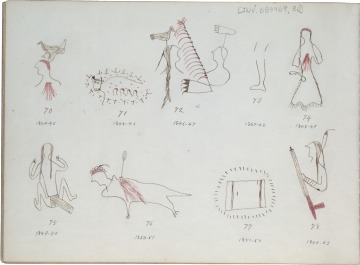1848: Successive epidemics spread across U.S., Alaska, Hawai‘i
In September, a series of deadly epidemics, including measles, whooping cough, and influenza, sweeps across North America and the Pacific. Survivors weakened by one virus are less able to withstand the others. Native peoples are severely affected. Some infections reach areas in the western U.S., Alaska, and Hawai‘i for the first time, where Native peoples have no resistance to them.
- Theme
- Epidemics
- Region
- Arctic, California, Great Basin, Great Plains, Hawai‘i, Northeast, Northwest Coast, Plateau, Southeast, Southwest, Subarctic
The Lakota marked the passage of time by drawing pictures of memorable events on calendars called winter counts. This picture, titled "Many Died of the Cramps," is for the year 1849–1850. It was created by Oglala Chief American Horse in 1879, from a winter count on cloth that had been kept in his family for several generations.
Winter counts were physical records used in conjunction with oral history. The events used to name the years were not necessarily the most important things that happened, but ones that were memorable and widely known within the community.
Courtesy National Anthropoligical Archives, Smithsonian Institution
